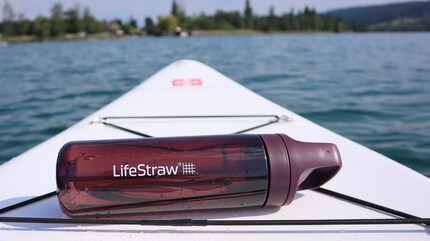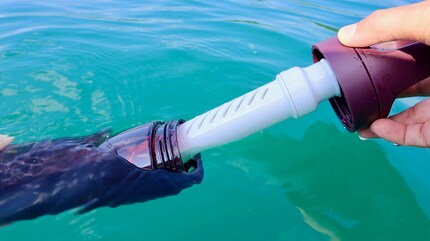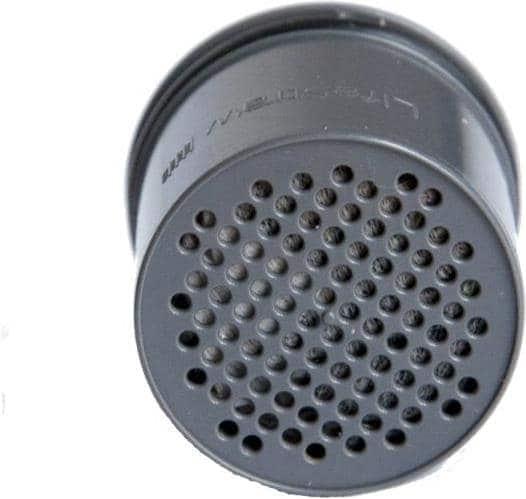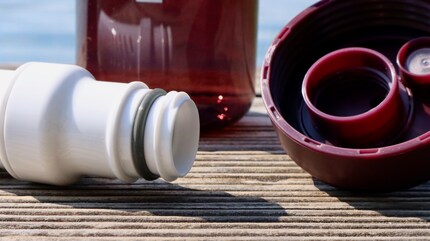
Product test
Drinking water to go: the Larq bottle on trial
by Siri Schubert

Without drinking water, sports and outdoor activities quickly come to an end. Carrying litres of water with you is a real brake on fun. And drinking from streams and lakes can have unpleasant consequences. That's why I'm testing various water filters and purification systems in a series. Let's start with the Lifestraw Go Bottle, which has just been updated.
The Lifestraw membrane filter removes 99.9 per cent of all bacteria and parasites. Microplastics and other particles from a diameter of 0.2 microns are also filtered out. You can easily fill the bottle in a lake, stream or river. Then screw on the cap with the filter and you can drink from the mouthpiece. As the filter also retains suspended particles, the water you drink is clean, even if it appears cloudy in the bottle.
The activated carbon filter in the upper part of the filter reduces chlorine, pesticides and herbicides. It also ensures that the water tastes pleasantly fresh. The membrane filter needs to be replaced after around 4,000 litres and the activated carbon filter after around 100 litres. You can easily buy both again.
I have been using the Lifestraw Go bottle for several years now. Previously, it had two disadvantages for me, which have been remedied with the new Lifestraw Go Bottle. The innovations have just been presented at the Outdoor by ISPO trade fair. The Lifestraw bottles with the updates will soon also be available in the Galaxus shop.
The second innovation is the drinking spout and the screw-on lid. Previously, the drinking spout recessed into the lid could be opened. I didn't find that particularly hygienic. Because if I'm outside with dirty hands on the mouthpiece, even filtered water that I drink through the mouthpiece is only half as useful.
In addition, the old system was not completely leak-proof. Because water leaked out, I was reluctant to take the Lifestraw bottle with me in my rucksack or sports bag. The new lid solves the problem. With the screw cap, the bottle is leak-proof and has already survived a hike in my rucksack without leaking.
The Lifestraw Go bottle is well suited for many outdoor adventures. I have not had a problem drinking water from lakes and streams. Even on holiday, when I don't fully trust the tap water, I like to drink from the bottle.
However, the Lifestraw Go bottle does have its limitations: The membrane filter cannot do anything against viruses such as the diarrhoea-causing noroviruses, as viruses can slip through the pores due to their small size. Viruses are always found in bodies of water, either due to contamination near residential areas, in agricultural areas or when animals have died near the water (although the latter is rather rare and hardly predictable).
Research diver, outdoor guide and SUP instructor – I love being in, on and around water. Lakes, rivers and the ocean are my playgrounds. For a change of perspective, I look at the world from above while trail running or flying drones.
When I'm doing water sports and hiking, I'm surrounded by bodies of water. But drinking directly from them is not a good idea because of contamination from bacteria, insect larvae, parasites and microplastics. The closer a body of water is to settlements and agricultural land, the greater the likelihood that it is contaminated with intestinal bacteria such as E. coli. When water levels are low after dry periods, the concentration of bacteria is usually higher. Heavy rain is also problematic, as harmful substances can be washed into the water. I often use the Lifestraw Go bottle to prevent my outdoor trip from turning into a potty party.



LifeStraw Activated carbon capsules for Steel and Go 2-stage
2 x
In previous models, you could put the filters in the drinking lid. This was convenient, but I was never 100 per cent sure whether the filter had slipped out easily and I was unintentionally drinking dirty water. However, because the bottle with filter was so practical, I always checked that the filter was still in place before drinking. It never fell out and I never had any stomach problems. Nevertheless, I found the solution less than ideal. The filter is now available with a screw coupling. After screwing it in, it sits firmly, doesn't wobble and I feel safer when I drink filtered water from the bottle.


There are various methods for eliminating viruses. In the past, I have used the Micropur tablets from Katadyn. Although these are effective against viruses, bacteria and amoebae, they leave behind an unpleasant taste. It also takes up to two hours to destroy amoebae, viruses and protozoa. If you're thirsty while hiking, that's a very long time to wait.
Another method is artificial UV light, which kills viruses in the water. A Steripen does just that. With the Steripen, which requires AA batteries, you stir around in a litre of water for 90 seconds until the green light signal indicates the end of the cleaning process. Viruses, bacteria, protozoa and parasites should then be destroyed. The short-wave UV-C radiation destroys the DNA of the microorganisms. However, you need a bottle with a large opening and the water should be relatively clear, as suspended particles impair the effectiveness.
As I don't have access to a laboratory, I can't say with 100 per cent certainty how well it works. However, I do have anecdotal evidence from a trip to the Thur with two colleagues. I first treated my water with the Steripen and then drank it through the filter of the Lifestraw Go bottle. The two colleagues only used one filter. I was fine afterwards, they both got severe diarrhoea and were diagnosed with a norovirus infection. This is at least an indication that UV light works.
However, I didn't always find it practical to treat the water with the Steripen first and then drink it through a filter to remove sediment and microplastics. I had to carry an extra device with me and couldn't forget an extra step to purify the water. That's why my new favourite is the self-purifying Larq drinking bottle with built-in UV mechanism, which I tested and will introduce in the second part of the series.

Siemens EQ700 integral TQ717D03